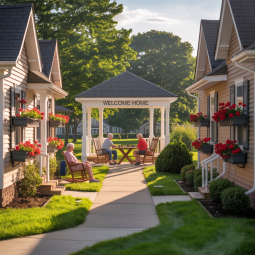
Innovative Seniors' Housing Options
- Housing
- by SeniorCareAccess
- connect@lifestyle55plusntwork.com
This article was originally published on 5/1/2021 and reflects the information available at that time. While it still provides valuable insights, we've created a new and updated article on this topic to provide more current and engaging content. You can find the latest version at https://www.seniorcareaccess.com/article/innovative-seniors-housing-options-in-canada-2025-update
We are entering a time of change and challenge.
Within 20 years, 25% of our population will be over 65. The seniors of the future are tech-savvy, educated, and demanding. It is clear that the boomers of yesterday (who are, in fact, the seniors of tomorrow) will control the way we do things and the options that will be available to them. They are already beginning the process of inspiring the housing industry to be innovative…..We know that the number of seniors is growing to previously unseen proportions and, as a result, there will be a need to develop many different kinds of housing solutions that will meet the needs of many with different budgets and care needs, while allowing people to remain active and independent for as long as possible.
Twenty years ago, options were limited to retirement homes and nursing homes, which were clearly defined by care provision. Retirement homes were for the independent, and nursing homes were for those who needed care. Now, the lines between the levels are 'fuzzier'. We have assisted living, dementia care, independent living, life lease structures, condos for seniors, and other types of residences that fall somewhere in between. Many retirement settings are providing care similar to that of nursing homes. People are staying in their own homes longer and are more likely to 'downsize' before moving to a place with 'care'. The age at which people go into care settings is older than in the past, and in the future, the age we decide to relocate because we need care may be even older.
Many of the new structures being built are luxury hotel-style accommodation, some have ownership options, and most are moving toward an 'active living' model. There is a major focus on health, wellness, and active aging. There is a move toward separating 'care' from 'accommodation' by allowing for amenities with flexibility. There is a significant number of places offering “memory care,” so those with forms of dementia are not limited to nursing homes when looking at options for care.
In addition, there are other trends for senior housing choices occurring in North America and around the world that may indeed impact us in the future as we too look toward innovative options for the future. Congregate housing is a bit like co-op housing communities for seniors and is common in parts of the USA where virtual 'villages' of seniors exist. Campuses of Care or Continuous Care Retirement Communities (CCRCs) are settings where you can 'stay for life' as all levels of care are in one community or under one roof; people can move between levels as their needs change and couples at different levels can stay under one roof or within the same complex. College Campus Housing is housing for seniors (either rental or condo-style) built right on University or College property. This concept feeds the desire for some seniors who love to learn and enjoy access to an educational atmosphere where they can take courses if they wish. Senior Co-housing is a relatively new concept in Ontario, but common in parts of the USA, is co-op housing with a twist. There is usually an ownership component that can be costly and time-consuming to set up, but essentially this type of housing allows for privacy but shared decision-making and activities. Some communities are intergenerational as well.
In addition to the innovative types of communities being developed, there are also advances in technology that allow people with limited care needs to remain in their own homes while being monitored by devices that assist in keeping them safe. These advances are very beneficial for long-distance caregivers, but they still have their limitations.
Other examples of different types of retirement living options include Naturally Occurring Retirement Communities (NORCs), which are becoming quite prevalent in parts of the USA where the government provides services to seniors in a defined area, allowing them to stay in their own home with supports. In some parts of the world, we are seeing the development of small-scale retirement communities in home-like environments; in others, there is a move towards apartment-style dwellings in large urban centres, and in others, we read of the concept of 'apartments for life' where mixed levels of care are available.
As the population demographic changes communities are also going to have to look at infrastructure changes to accommodate issues and gaps in service for seniors - things like more benches in public areas, safer sidewalks, extended crosswalk signals, and ‘senior-friendly’ public transit systems will all need to be assessed as the needs of communities change.
While the options of today seem copious compared to those of 20 years ago, it is clear that what we have now is only the beginning. With technology and innovative thought - and the goal of maximizing independence in a cost-effective way - there is unlimited potential for different in-home 'aging in place' options and retirement communities to develop in the future.